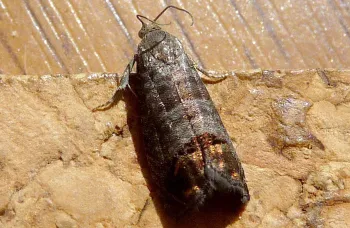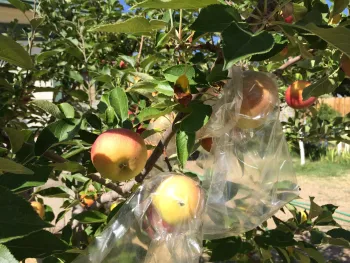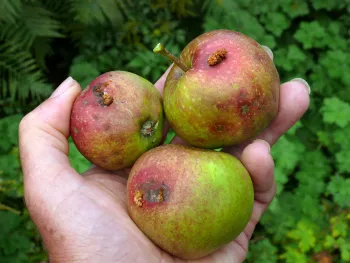
If you have fruit trees, especially apples, pears, or walnuts, now is the time to be on the lookout for the codling moth. This is the time of year (mid-March to early April) when the adult codling moth, a little grayish-brown lepidopteran, emerges from its cocoon.
It has spent the winter pupating, most likely in the bark and debris around the base of the tree, and is now ready to begin the next mating cycle. The new moths rest during the day, becoming active around sunset, and begin to mate when temperatures get into the low 6's. Impregnated females lay their eggs on the tree's leaves, developing fruit. The tiny white eggs will hatch within a couple of weeks, and the larvae, little worms with pinkish white bodies and brown heads when mature, begin to feed on existing fruit by borrowing in, heading towards the fruit's core, leaving behind a brownish mater al. Now you have the dreaded "worm in the apple," damaging the fruit and making it undesirable for both orchardists and home gardeners alike. This "worm" matures in the fruit and then emerges to spin another cocoon to begin another codling moth life cycle, perhaps as many as four in any given season.

To control fruit damage and infestation by the codling moth larvae, fruit orchardists follow a routine based on this life cycle. Home gardeners can do much the same, beginning with cultural control focused on sanitation. Keep the area around your tree clean of debris and fallen fruit where overwintering codling moths can develop in cocoons. Keep your tree well-pruned and free of old fruit. Keep a close eye on your tree, looking at leaves and young fruit for codling moth eggs and larvae (beginning March and April). Scraping eggs, larvae, and cocoons into plastic bags can help. In May and June, look for "stings," entry wounds on the fruit where larvae have begun burrowing into the fruit. These holes are often filled with brown frass (insect excrement) and are easily recognizable. Promptly remove any infested fruit from the tree or the surrounding ground and dispose of it properly. You can also thin and bag healthy fruit when it is small to protect it from infestation – it is a little bit work intensive but helpful if you want to go a step further to control infestation without pesticides. Go to https://ipm.ucanr.edu/PMG/PESTNOTES/pn7412.html for a description of this technique.

If cultural steps don't keep the codling moth away from your tree, or at least under control, a couple of safe biological agents are available to home gardeners. Codling moth granulosis virus (sold as Cyd-X) is a pesticide that won't harm beneficial insects, including bees. You can increase its effectiveness by adding 1% horticultural oil. You can apply it every seven days after eggs hatch for at least three or four times per generation. Spinosad is safe, although more toxic to beneficial insects than Cyd-X. Timing is key to the application of these controls. Spraying must be done before or just as eggs are hatching since larvae are protected from insecticides once they enter the fruit. Spraying needs to be repeated with each generation. A pheromone trap can be hung in your tree in late March to alert you that the codling moth has shown up, and your monitoring of egg hatch should be in. This can be done by observing your tree or using degree/day calculations.
It takes a bit of effort to keep your fruit tree free of this persistent pest, but worth it. Few simple things in life are more joyful than biting into a healthy, freshly picked apple (or pear) from your garden on a warm summer's day!
By Wendy Irving, March 29, 2025


